
The Golden Pass LNG plant, a flagship project in the U.S. liquefied natural gas (LNG) sector, is gearing up for its inaugural shipment in February 2026. This milestone marks a significant step forward for the joint venture between QatarEnergy and ExxonMobil, positioning the facility as a key player in meeting global energy demands. As commissioning activities wrap up, the plant is on track to begin commercial operations, contributing to the U.S.’s dominance in LNG exports.
The Joint Venture: QatarEnergy and ExxonMobil’s Strategic Partnership
The Golden Pass LNG project is a collaboration between QatarEnergy, which holds a 70% stake, and ExxonMobil, with the remaining 30%. This partnership leverages QatarEnergy’s expertise as one of the world’s largest LNG producers and ExxonMobil’s extensive experience in U.S. natural gas operations. The venture aims to transform the existing Golden Pass import terminal in Sabine Pass, Texas, into a major export hub.
Originally conceived in 2019, the project received a boost from high-level endorsements, including a signing ceremony attended by U.S. Secretary of Energy at the time.
The collaboration allows both companies to independently market their shares of the LNG output, enhancing flexibility in global sales.
QatarEnergy brings its vast reserves from the Middle East, while ExxonMobil integrates the project into its broader strategy to nearly double its LNG supply by 2030 through low-cost, efficient developments.
The Golden Pass LNG Plant: Overview and Operations
Situated on the Gulf Coast in Texas, the Golden Pass LNG facility is designed to produce up to 18.1 million metric tons per annum (mtpa) of LNG across three trains.
The plant’s expansion from an import terminal to an export powerhouse involves adding liquefaction units, pipelines, and compressor stations.
Recent developments include the arrival of a cooldown cargo from QatarEnergy’s Ras Laffan facility in early December 2025, a standard step in commissioning.
The U.S. Department of Energy (DOE) has approved extensions for LNG exports and re-exports, ensuring the project can operate through 2050.
With Train 1 expected to produce LNG by the end of 2025, followed by Trains 2 and 3 in sequence, the facility is poised to ramp up output amid growing Gulf Coast gas demand.
This positions Golden Pass as the ninth large-scale U.S. export terminal, underscoring America’s pivot from LNG importer to global leader.
Investment Costs and Economic Impact
The project represents a substantial investment, initially estimated at around $10 billion.
However, challenges, including construction delays and cost overruns, have pushed the total closer to $11.6 billion, with reports of at least $2.4 billion in additional expenses.
These overruns stem from factors like supply chain issues and extended timelines, with the start-up delayed from an original target to late 2025 or early 2026.
Despite the higher costs, the investment is expected to generate billions in economic growth for the region, including job creation and infrastructure development.
The joint venture has also secured agreements for additional gas supply from partners like Entergy Texas and Kinder Morgan, ensuring reliable feedstock.
Potential Returns to Investors
For investors in ExxonMobil (XOM) or related energy funds, Golden Pass offers promising long-term returns as part of a portfolio aimed at capitalizing on rising LNG demand. ExxonMobil anticipates the project will help double its global LNG supply by 2030, driving revenue growth in a market where U.S. exports are set to capture one-third of global volumes.
Analysts project that facilities like Golden Pass could yield strong cash flows, especially with LNG prices expected to average around $4.00 per million British thermal units (MMBtu) in 2026.
The project’s strategic U.S.-Qatar ties add a layer of geopolitical stability, potentially enhancing investor confidence amid global energy shifts.
While exact ROI figures are proprietary, similar LNG projects have delivered returns through tolling agreements and spot market sales, with ExxonMobil expressing optimism about the venture’s viability.
What Investors Should Look For
Investors eyeing exposure to Golden Pass or the broader LNG space should monitor several key factors:
Operational Milestones: Watch for successful commissioning of all trains and the first commercial cargoes, as delays could impact short-term returns.
Market Pricing and Demand: LNG spot prices, influenced by weather, geopolitical events, and competition from renewables, will dictate profitability. Keep an eye on European and Asian demand trends.
Regulatory Environment: U.S. export approvals and potential policy changes under future administrations could affect timelines.
Geopolitical Risks: Tensions in key regions like the Middle East or Europe may disrupt supply chains but could also boost U.S. LNG premiums.
Sustainability Metrics: With growing emphasis on low-emission energy, projects incorporating carbon capture or methane reduction could attract ESG-focused capital.
Diversifying across upstream gas producers, midstream infrastructure, and downstream marketers can mitigate risks in this volatile sector.
Global LNG Market Outlook for the Foreseeable Future
Looking ahead to 2026-2030, the global LNG market is poised for transformation, with a surge in supply reshaping dynamics. The International Energy Agency (IEA) forecasts natural gas demand growing by nearly 1.5% annually through 2030, adding about 380 billion cubic meters (bcm) to global consumption.
Supply capacity is expected to rise by around 350 bcm by 2030, a 54% increase from 2024 levels, driven largely by U.S. and Qatari expansions.
However, forecasts vary: BloombergNEF projects a supply surplus of 15 million metric tons by 2030 in its base case, potentially pressuring prices.
Europe, a major importer, may see declining gas demand through 2030, while Asia—particularly China and India—drives growth.
Geopolitical factors, flexible contracts, and the push for energy security will influence the market, with U.S. LNG playing a pivotal role in tightening global price spreads.
In summary, the Golden Pass LNG plant’s February 2026 shipment debut underscores the U.S.’s ascending role in global energy. For investors, the project offers a blend of opportunity and caution in a market brimming with potential but sensitive to external forces. As the world transitions toward cleaner energy, initiatives like this will be crucial in bridging the gap.









